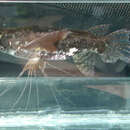Diagnostic Description
provided by Fishbase
Compressed body, flattened on the dorsal side and head, careened on the ventral side behind the pelvic fins (Ref. 2921, Ref. 13851). Large mouth, with numerous teeth and a prominent lower jaw (Ref. 2921), upwardly directed (Ref. 3054, Ref. 42873). Short dorsal fin placed very posterior on the back (Ref. 2921), inserted behind the longer anal fin (Ref. 3054, Ref. 13851). Large development of the pectoral fins (Ref. 2921, Ref. 3054), enlarged and wing-like (Ref. 42873). Very advanced position of the pelvic fins, with 4 elongated, filamentous rays (Ref. 2921, Ref. 3054). The caudal fin is long, pointed and rather ragged, with the two centre rays the longest (Ref. 13851). Large cycloid scales (Ref. 2921), subcircular, with rounded but evident laterobasal angles (Ref. 53264): 26-30 lateral line scales, 21-26 predorsal scales (Ref. 52030, Ref. 52046). Extremely brilliant colored (Ref. 2921): dorsal side of the body olive-colored, ventral side silvery yellow amplified with carmine; sometimes with darker transversal bands on the back (Ref. 2921, Ref. 3032). The fins are vivid pink-colored with small brown-violet spots, forming transversal bands on the pectoral fins, and tinted with violet on the inside and extremities (Ref. 2921).
Diseases and Parasites
provided by Fishbase
Fin Rot (early stage). Bacterial diseases
Diseases and Parasites
provided by Fishbase
Aeromonosis. Bacterial diseases
Diseases and Parasites
provided by Fishbase
Bacterial Infections (general). Bacterial diseases
Life Cycle
provided by Fishbase
It lays 80 to 220 eggs (Ref. 13371). The eggs have a diameter of about 1.5 mm (Ref. 41580).
Migration
provided by Fishbase
Potamodromous. Migrating within streams, migratory in rivers, e.g. Saliminus, Moxostoma, Labeo. Migrations should be cyclical and predictable and cover more than 100 km.
Morphology
provided by Fishbase
Dorsal spines (total): 0; Dorsal soft rays (total): 6; Analspines: 0; Analsoft rays: 9 - 15
Trophic Strategy
provided by Fishbase
It lives in swamps, creeks and buckwaters (Ref. 31256), and inhabiting the calmer parts of the rivers (Ref. 41580). It can leap out of the water. Exophageous insectivore, mainly feeding on terrestrial insect and aquatic larvae and nymphs of insects (Ref. 41580). Feeds also on crustaceans and fish (Ref. 7020).
- Recorder
- Drina Sta. Iglesia
Biology
provided by Fishbase
Pantodon buchholzi is a creature from calm waters (Ref. 51626). It lives in swamps, creeks and backwaters (Ref. 31256), and inhabits the calmer parts of rivers (Ref. 41580), where it can be seen on the surface waters (Ref. 4910). They are capable to jump out of the water, to search for insects or to escape from predators (Ref. 2921). It is not a glider, but a ballistic jumper (Ref. 52282), with a tremendous jumping power (Ref. 31256). It is an exophageous insectivore, feeding on terrestrial insects and aquatic larvae and nymphs of insects (Ref. 41580). It also feeds on crustaceans and fish (Ref. 7020). Introduced in 1905 to European aquarists (Ref. 51626, Ref. 53207). Pantodon buchholzi is a favorite fish for aquarists; in the aquarium it can rest with the top of the head and the large pectoral fins touching the surface, while the long rays of the pelvic fin hang down perpendicularly, forming a tempting morsel for other aggressive fish in the same tank, and therefore it should be stocked together with only bottom dwellers (Ref. 13851). Observed maximum length of 15.0 cm TL in aquarium (Ref. 2921, Ref. 3515).
Importance
provided by Fishbase
fisheries: of no interest; aquarium: commercial

